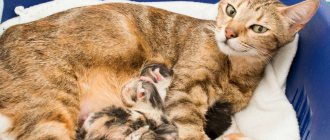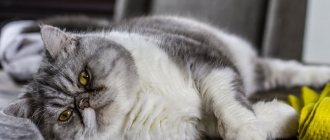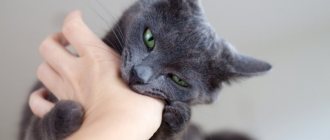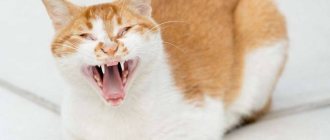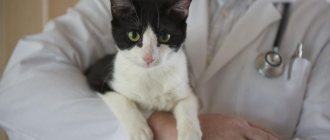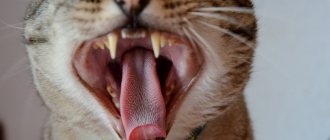Why does a cat breathe frequently from its belly?
The normal breathing rate for a cat is considered to be from twenty to forty exhalations per minute. However, there are situations when a pet’s breathing is impaired. When a cat breathes with its stomach, the lungs and chest cannot cope with their functions, since in a normal case a vacuum forms around the lungs in the chest cavity and allows the organs to have space. Due to certain problems with the body, both air and blood along with harmful substances can enter the cavity. This may also be due to increased physical activity, various pathologies and severe climatic conditions. This can also be caused by the onset of labor in a cat and stressful situations. Any of these options will be a reason to visit a doctor.
Language functions
To understand why a cat sticks out its tongue, you first need to understand what functions this muscular organ performs. A cat's tongue performs a number of important functions:
- helps in the process of swallowing, nutrition;
- allows you to recognize the taste of food;
- allows for hygiene procedures.
In its normal state, the tongue is located in the mouth. But there are times when the owner complains that the cat constantly sticks his tongue out. But this phenomenon is not always considered pathological. There are also physiological reasons why a cat sticks out the tip of its tongue.
Why does the cat breathe quickly and stick out his tongue?
Everyone is familiar with the situation when a cat sticks out its tongue to wash itself or lap up milk. However, there are situations when you should worry about the condition of the animal.
First, let's look at situations where you don't need to worry:
- Forgetfulness. From time to time, cats forget themselves and go into the astral plane without hiding their tongue. Usually occurs after washing.
- Relaxation. All muscles relax during sleep; cats may develop a red stripe between their teeth. This is also the norm.
- Thermoregulation. During the heat, the cat may become hot; in order to relieve the situation, the cat sticks out its tongue, but this may indicate a possible heat stroke, so it is necessary to move the cat to a cool room and give it something to drink.
But if the cat breathes frequently, while opening its mouth, then you need to sound the alarm. The mechanism for the occurrence of problems in terms of breathing is quite simple: to improve gas exchange in the lungs and better supply of air there, the animal needs to breathe more often and deeper, which is why it has to open its mouth, stick out its tongue and lower it beyond the boundaries of the oral cavity. The cause can be a wide variety of diseases such as rhinitis, sinusitis, pulmonary inflammation and many other diseases.
And it is also important to note that the cause of this phenomenon is cardiovascular failure, poisoning and disorders in the brain. When poisoning occurs, vomiting occurs, the animal begins to cough, and as a result, all harmful substances leave the body. When disturbances occur in the brain, the cat is unable to control the movements of its body, including its tongue. Additionally, the cat may be accompanied by strabismus and other diseases.
Physiological reasons
Sometimes a protruding tongue is explained by simple physiology. In these cases there is nothing to worry about.
Washing
You can often see a cat sitting with its tongue hanging out after a long wash. Perhaps this is how she relaxes her muscles or meditates.
Relaxation
When a cat sleeps, the muscles of the tongue are relaxed and it naturally lengthens. Therefore, the animal’s mouth is half open and the tip of this muscular organ protrudes from it.
Stressful situations
Many animals, when in an excited state, are characterized by rapid breathing. The protruding tongue facilitates the passage of oxygen to the respiratory tract.
Overheat
Both dogs and cats, when they are hot, breathe heavily with their tongues hanging out. And this is a physiological norm - this is how they cool down. After all, they have practically no sweat glands; a small amount of them is located only on the pads of their paws.
However, pets also behave the same way after a long run or other physical activity.
Sexual rut
A protruding tongue can be seen in a male when he is excitedly “courting” a female, and this is also considered a physiological norm.
Childbirth
During the birth of kittens, the cat breathes heavily, constantly licks itself, forgetting to remove its tongue. At this point in her life, this is an absolutely normal sign, as she is very tense, tired, and may have a fever.
Nausea
Some pets get motion sickness from riding in a car. A sign of impending nausea and vomiting can be the tip of the tongue sticking out of the mouth.
The same situation occurs with a pet after anesthesia, for example, after sterilization or castration. But here general muscle weakness joins nausea.
Sounds
A certain frequency of vibration of sound waves causes reflex yawning and the effect of protruding the tongue in cats. For example, if you run your finger over the teeth of a fine-toothed comb or tear off some tape.
The main causes of deterioration in breathing in cats
The reasons leading to deterioration of breathing in cats include symptoms such as:
- Unusual sounds or wheezing that your pet has never heard before.
- A posture that expresses anxiety or an inability to lie down in a comfortable position.
- Lips are pale, gums are bluish, lips may also have a bluish tint
- Breathing is rapid, with visible effort on inhalation and exhalation.
- Breathing occurs with an open mouth.
Also, the causes may be the consequences of heart disease, which lead to heart failure, metabolic disorders, filling the space in the chest with harmful substances, as well as the presence of foreign objects, for example, a piece of food that has fallen into the wrong throat, or plants, especially with sharp stems and leaves. In addition, gas exchange disorders when blood does not enter the body can interfere with breathing. This may occur due to previous injuries, swelling in the lungs, or pneumonia.
How to provide first aid to an animal?
In most cases, the best treatment for a cat with breathing problems is to take her to the hospital immediately. By trying to do something on their own, owners are only delaying time, which aggravates the situation. At the slightest suspicion of pathology of the heart, lungs or other organs, you need to call a veterinarian or take the cat to him. However, there are exceptions to the rules :
- For example, if a pet breathes through its mouth and a foreign body gets into the throat. In such cases, even a person without medical education is able to provide first aid. You need to open the cat's mouth wide, pull on the tongue and try to pull out the foreign body with your fingers or tweezers. If it is not stuck deeply, this will most likely be possible.
- In cases where a foreign object has entered the trachea, you can try to turn the cat upside down, lift it by the hind legs and squeeze the stomach in the diaphragm area. As a rule, a foreign body pops out as a result of such manipulations. If this does not happen, the animal must be urgently taken to the doctor.
Diagnosis and prevention of diseases
To correctly diagnose respiratory diseases in cats, it is necessary to organize disease prevention and treatment. First you need to study the cat's medical history and the results of a physical health examination. The upper respiratory tract is examined using an x-ray, and it is performed in the presence of diseases of the lower respiratory tract, for example, cough, difficulty breathing or rapid breathing. Doctors often use devices to examine the nose, throat, and respiratory system. If there is a suspicion of a lung disease, it is necessary to analyze what is contained in the lungs and respiratory system by washing the trachea or sacs with a sterile liquid and further studying the resulting liquid. This procedure is called transtracheal flushing.
Cats that have a lot of fluid in the pleural area need to have it pumped out using a special needle, and then this fluid is examined under a special microscope. If there is a lot of fluid, then this is the cause of possible heart disease; for a more complete result, an electrocardiogram procedure is necessary.
Prevention is that cats develop diseases as a result of stress, certain health problems, climate conditions, as well as dust, dampness, and drafts. Some types of diseases can be cured through vaccination. However, in any case, it is necessary to comply with sanitary standards for keeping cats.
Providing first aid to a cat
It is necessary to secure the cat so that its neck is straight and in line with the spine; The pet’s mouth should be closed, the mouth should be free of saliva, foam, and mucus; We take a deep breath, exhale air into the nose through the palm, which is folded into a tube. You can cover the cat’s mouth with a thin scarf and clasp the nose with your lips without using your palm; frequency approximately twenty times per minute, depth will depend on the size of the pet.
Kittens need to be given artificial respiration in an extremely careful manner, since exhalation that is too intense can damage the small lungs (they simply will not be able to accommodate the volume of air exhaled by a person). To calculate the volume, place your palm on the cat’s chest: a slight expansion is enough, do not overdo it; We check the pulse every 15–20 seconds.
If your heart has stopped, don’t panic! Usually, if the cat can still be saved, the heart rate is restored within ten to fifteen minutes of indirect massage; We wrap our palm around the cat’s sternum from below so that it becomes sandwiched in the area between the thumb on one side and the remaining fingers on the other. We sharply squeeze and unclench our fingers (five times in a row), then blow air into the cat’s nasal openings once, then again five compressions of the chest.
Every two minutes we check to see if the heart is beating. It’s great if there is an assistant nearby: one person performs artificial respiration, and the second one continuously massages the heart.
Transporting cats to the veterinary clinic
Ten tips for transporting your cat to the veterinary clinic:
- You should never move your cat in a car unless you have a special container.
- Use a rigid container that opens from the top and front, which will allow you to perform an initial examination of the cat without removing it from the container. It is necessary to select practical and safe containers.
- Store the container in such a way that the cat perceives it as part of the interior and can get used to it.
- Make the container as comfortable and recognizable to your cat as possible by placing objects inside it that have your scent and the cat's scent (you can do this by simply rubbing a piece of cloth on the cat). Use a special spray containing pheromones (Feliwey) - spray it on the bedding material of the container at least 30 minutes before transporting the cat to the veterinary clinic. Remember that your cat may get dirty during the trip, so be sure to bring extra bedding.
- If the cat does not want to go into the container on its own, you need to carefully pick it up and carefully place it in the container on top. If this does not help and the cat is still resisting, you need to wrap it in a thick towel (either scented or treated with a pheromone spray) and then place it in a container.
- You need to place the container in the car so that it is in a stable position during the trip, placing it on the floor behind the front seat or securing it with a seat belt. Drive at a careful pace, do not listen to loud or heavy music, and talk calmly to your cat while driving. Some cats will like to see what's going on outside, but most will feel more relaxed if you cover the container with a towel during the trip.
- On the way from your car to the clinic, try not to jerk the container or knock it against your feet.
- We recommend that while waiting at the veterinary clinic, place the container so that the front of it is facing you (and not towards other pets), and cover it with a towel.
- Of course, the same transportation conditions must be true on the way back.
- Last but not least, if you have more than one cat, you will need to take some precautions when returning one of the cats to your home, especially after a long stay at the clinic. Leave the cat in the container for a few minutes and observe the reaction of the other cats. If the cats are calm, you can open the container and let the cat out. If you notice that cats are feeling tense, this may mean that the cat returning from the clinic has an unfamiliar odor. It is necessary to place it in a separate room (of course, with a toilet, food and drink) for at least 24 hours so that it acquires a more traditional smell for other cats.
